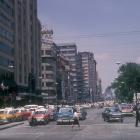Disaster frequently confronts residents of Mexico City. Earthquakes threaten the indiscriminate destruction of structures both precolonial and new, flash floods tease a waterlogged future reminiscent of the city’s lacustrine past, ashfall from volcanic eruptions brewing in close proximity carries the potential to cause bodily harm. An inescapable component of the lived experience in the Valley of Mexico, these environmental disturbances are also inscribed in the city’s cultural heritage: natural disasters, for instance, figure prominently in Mexica creation mythologies and tales of ferocious floods permeate the chronicles of Spanish conquistadores.
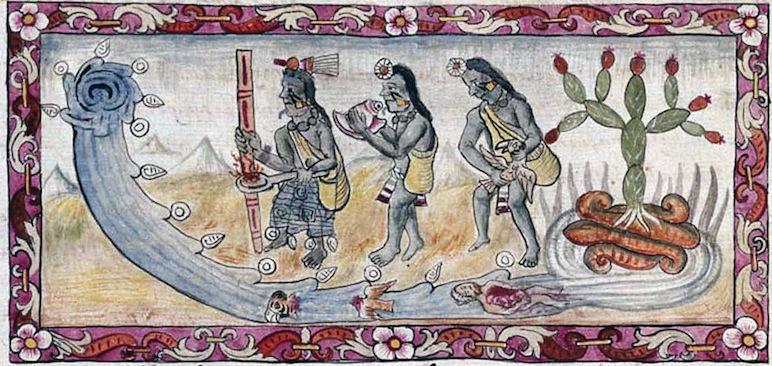
A painting by Frey Diego Durán depicting a ritual to appease the gods for flooding Tenochtitlán, circa 1500s.
A painting by Frey Diego Durán depicting a ritual to appease the gods for flooding Tenochtitlán, circa 1500s.
Painting by Frey Diego Durán, c. 1500s.
Accessed via Wikimedia on 12 June 2019. Click here to view source.
 This work is licensed under a Creative Commons Public Domain Mark 1.0 License.
This work is licensed under a Creative Commons Public Domain Mark 1.0 License.
Not every environmental risk in Mexico City enjoys such high visibility in the historical record or in the literal sense, however. During the last third of the twentieth century, Mexicans became uncomfortably familiar with a newly brewing crisis: a thick air pollution silently unfurling over the sprawling metropolis. To be sure, conceptions of the air as “unhealthy” were not new, as Matthew Vitz’s account of early-twentieth-century tolvaneras, or dust storms, illustrates. Colonial-era grievances about various odors wafting through the air reveal an even broader chronology for the city’s problematic air quality. Yet, the association of dirty air as “disastrous” constituted a break from previous definitions. Rendering this phenomenon a disaster was a complex and political process, further complicated by the fact that, unlike the more conspicuous disasters afflicting the city, air pollution was rather elusive. Even as evidence mounted of its deleterious effects on human health by the 1970s, the government lagged in implementing control measures. Delineating the capital’s air as a public health hazard carried significant implications for the realization of the city’s future as an economic and global powerhouse because it revealed the inherent unsustainability of the processes driving its growth.
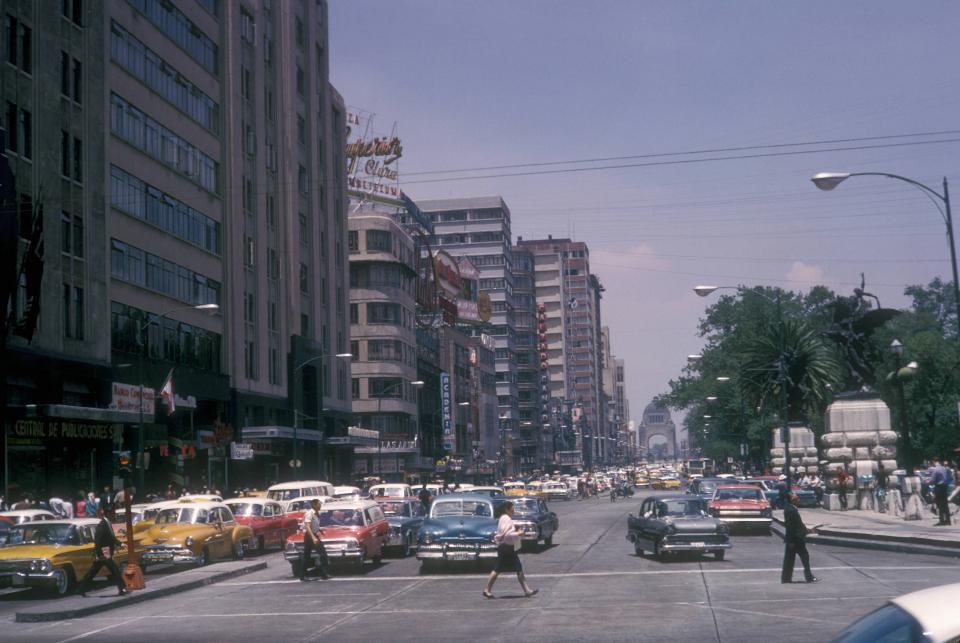
ONLY TO BE USED IN ELA MILJKOVIC’S ARCADIA ARTICLE.
ONLY TO BE USED IN ELA MILJKOVIC’S ARCADIA ARTICLE.
Photograph by Harold Mayer, 1966.
Courtesy of the American Geographical Society Library, University of Wisconsin-Milwaukee Libraries. Click here to view source.
Used by permission.
The copyright holder reserves, or holds for their own use, all the rights provided by copyright law, such as distribution, performance, and creation of derivative works.
From the 1940s to the 1970s, industrialization, population growth, and an automobile revolution collectively transformed the urban landscape, leading to the seemingly sudden onslaught of unclean air in the metropolitan area by mid-century. The deadly fogs, caused by the mass burning of coal, that long plagued some European and North American urban centers were absent in Mexico City due to, as John R. McNeill explains, its reliance on biomass, rather than coal, and its relatively later industrialization. Mexico City began its intense government-backed industrialization in the 1940s, culminating in the concentration of 33,185 industries within city limits by the mid-1970s, according to economist Gustavo Garza Villareal. This period also saw the city’s population swell from 1.5 million to 9 million, and a five-fold increase in the number of cars traversing the city’s roads. Mexico City’s unique geography, particularly its positioning atop a barren lakebed located at the bottom of a valley ringed by mountains that soar to 16,000 feet, proved incompatible with this spatial and demographic explosion, and served only to trap vehicle exhaust and chemical emissions near the surface.
Economic boom overshadowed the myriad environmental ramifications encoded within this aggressive developmentalism. Notably, anxieties surrounding economic productivity became the language through which nascent discourse on the deterioration of the city’s atmosphere first emerged. Early newspaper coverage of Mexico City’s esmog, a word adopted into the common lexicon by 1960, painted the capital’s dirty air as a nuisance rather than a serious health concern. Popular dailies maintained that air saturated with ash, smoke, and dirt could erode metal and damage property, threatening the day-to-day operations that fueled the city.
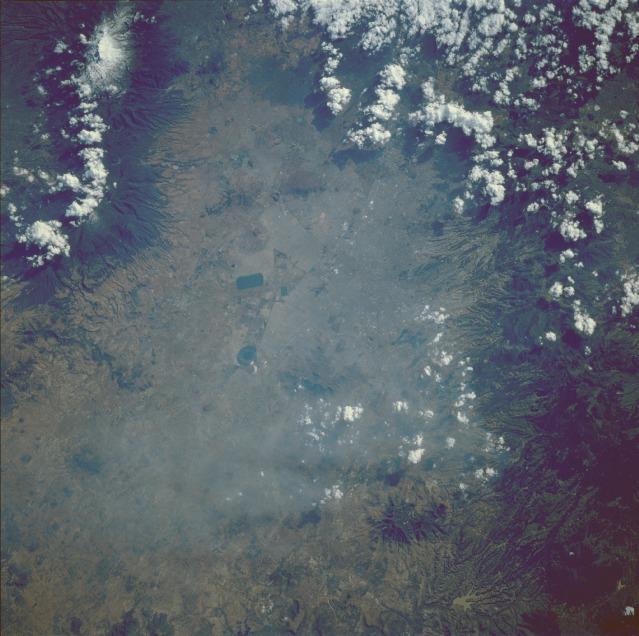
This 1985 astronaut photography of Earth captures a then-routinely hazy day in Mexico City—note Nabor Carrillo Lake, a rectangular water reservoir visible in the center of the image.
This 1985 astronaut photography of Earth captures a then-routinely hazy day in Mexico City—note Nabor Carrillo Lake, a rectangular water reservoir visible in the center of the image.
Photography by NASA, November 1985.
Courtesy of Earth Science and Remote Sensing Unit, NASA Johnson Space Center.
Click here to view source.
 This work is licensed under a Creative Commons Public Domain Mark 1.0 License.
This work is licensed under a Creative Commons Public Domain Mark 1.0 License.
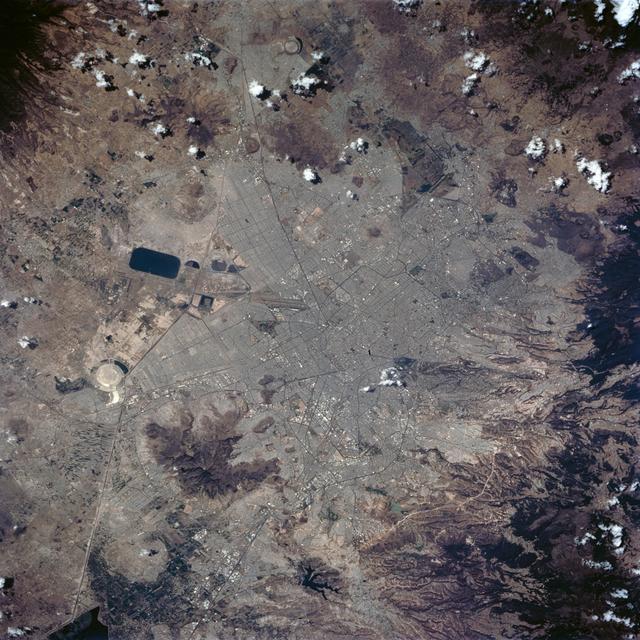
NASA astronauts captured this unprecedentedly clear day in Mexico City, March 1994, believing that the reduction of air pollution was due to the enforcement of strict regulations on vehicle and industrial emissions. Compare Nabor Carrillo Lake on the left with that of the previous image.
NASA astronauts captured this unprecedentedly clear day in Mexico City, March 1994, believing that the reduction of air pollution was due to the enforcement of strict regulations on vehicle and industrial emissions. Compare Nabor Carrillo Lake on the left with that of the previous image.
Photograph by NASA, March 1994.
Courtesy of NASA Image and Video Library, NASA Johnson Space Center.
Click here to view source.
 This work is licensed under a Creative Commons Public Domain Mark 1.0 License.
This work is licensed under a Creative Commons Public Domain Mark 1.0 License.
Indeed, journalists played integral roles in forecasting a city choked by its own air and arrested in development, but they were not the only actors to shape the dialogue. Businessmen involved in the tourism industry also expressed concerns that highlighted the augmented economic burden caused by air pollution when they complained that tourists were bypassing Mexico City for coastal areas like Acapulco and its ostensibly uncontaminated air. Still others, like the leaders of civic groups such as the National Association Against Air and Water Pollution imbued Mexico City’s persistent air pollution problem with more urgency. They routinely held open forums throughout the late 1960s to discuss Mexico City’s situation, from improving Mexico’s gasoline quality to proposing the creation of devices to eliminate motor vehicle exhaust fumes. Such symposiums democratized information about the city’s air, ultimately forcing the heretofore silent government into action via the promulgation of the nation’s, and Latin America’s, first antipollution legislation in 1971.
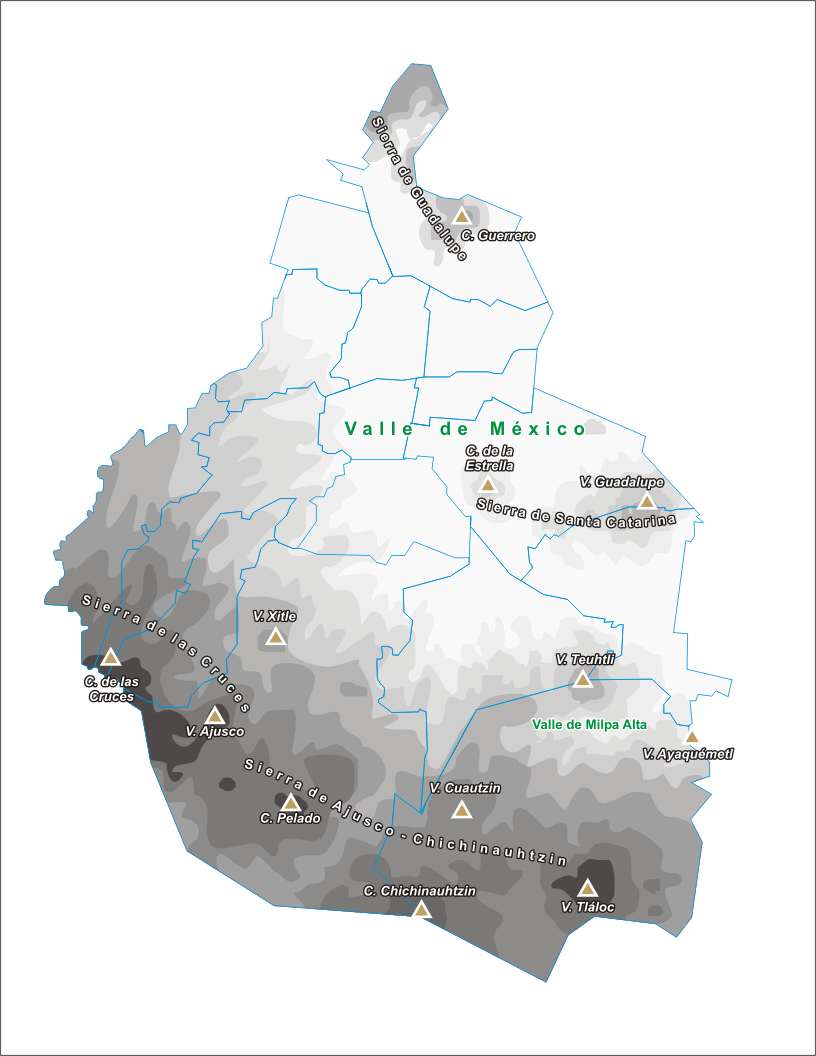
Map showcasing the “bowl-like” geography of Mexico City, surrounded by mountain ranges on nearly every side. This natural feature traps toxicants close to the surface.
Map showcasing the “bowl-like” geography of Mexico City, surrounded by mountain ranges on nearly every side. This natural feature traps toxicants close to the surface.
Accessed via Wikimedia on 12 June 2019. Click here to view source.
 This work is licensed under a Creative Commons Public Domain Mark 1.0 License.
This work is licensed under a Creative Commons Public Domain Mark 1.0 License.
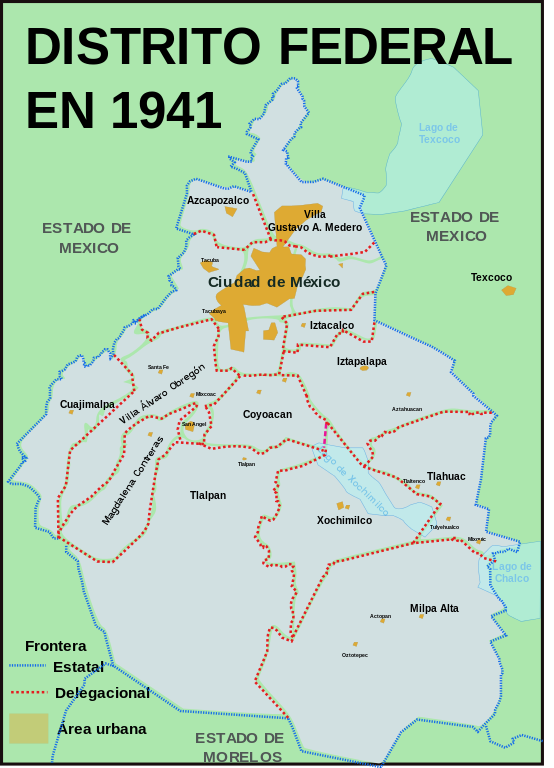
Federal District in 1941 (urban concentration appears in golden color).
Federal District in 1941 (urban concentration appears in golden color).
Map by Sarumo74, 2009.
Accessed via Wikimedia on 12 June 2019. Click here to view source.
 This work is licensed under a Creative Commons Attribution-ShareAlike 4.0 International License.
This work is licensed under a Creative Commons Attribution-ShareAlike 4.0 International License.
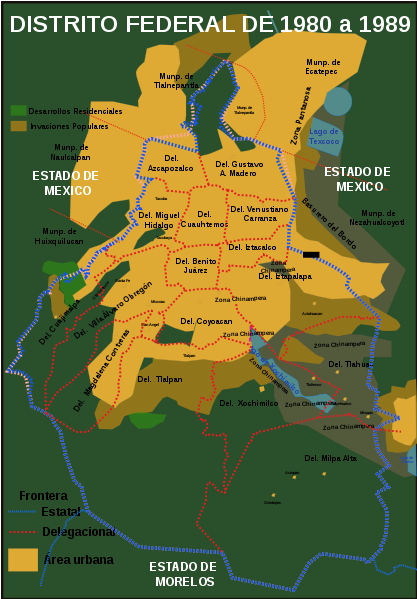
Federal District from 1980 to 1989 (urban expansion denoted by golden color).
Federal District from 1980 to 1989 (urban expansion denoted by golden color).
Map by Sarumo74, 2011.
Accessed via Wikimedia on 12 June 2019. Click here to view source.
 This work is licensed under a Creative Commons Attribution 3.0 Unported License.
This work is licensed under a Creative Commons Attribution 3.0 Unported License.
On paper, the law aimed to make the city’s air a subject of public policy by enforcing regulations on industrial emissions output, supporting scientific research, and educating the public, but when, in 1972, for example, doctors from the General Hospital of Mexico linked dirty air to declining health after studying compromised respiratory tracts and mucosal linings, they lacked an official channel to help broadcast their findings. The overall lukewarm enforcement of this law reflected the political and economic elite’s belief in the rewards of continued industrial development and progress.
While an intangible force, air pollution is not undetectable. Going into the 1990s, Mexico had passed its third clean-air law, but the capital’s air pollution attained an unparalleled visibility on individual and global scales. Ordinary residents were witnesses to shocking sights like pigeons falling dead mid-flight while astronaut photography captured Mexico City’s pollution from space. Only when the government formally recognized these disastrous effects by implementing programs like the no-driving day initiative in 1989, reducing leaded gasoline production in the early 1990s, and closing noncompliant industrial plants did Mexicans finally find some breathing room.
How to cite
Miljkovic, Ela. “A Killer Air: Delineating Disaster in Mexico City.” Environment & Society Portal, Arcadia (Autumn 2019), no. 45. Rachel Carson Center for Environment and Society. doi.org/10.5282/rcc/8803.
ISSN 2199-3408
Environment & Society Portal, Arcadia
 This work is licensed under a Creative Commons Attribution 4.0 International License.
This work is licensed under a Creative Commons Attribution 4.0 International License.
2019 Ela Miljkovic
This refers only to the text and does not include any image rights.
Please click on an image to view its individual rights status.
- Lezama, José Luis. “Metropolitan Environmental Management: The Case of Air Pollution in the Valle de México.” Population, City, and Environment in Contemporary Mexico, edited by José Luis Lezama and José B. Morelos, 487–526. México, D.F.: El Colegio de México, Center for Demographic, Urban, and Environmental Studies, 2006.
- McNeill, John R. “Latin American Environmental History in Global Perspective.” A Living Past: Environmental Histories of Modern Latin America, edited by John Soluri, Claudia Leal, and José Augusto Pádua, 266–276. New York: Berghahn Books, 2018.
- Oliver-Smith, Anthony, and Susanna M. Hoffman, eds. The Angry Earth: Disaster in Anthropological Perspective. New York: Routledge, 1999.
- Simon, Joel. “The Sinking City.” Endangered Mexico: An Environment on the Edge, 60–90. San Francisco: Sierra Club Books, 1997.
- Simonian, Lane. Defending the Land of the Jaguar: A History of Conservation in Mexico. Austin: University of Texas Press, 1995.
- Soto Coloballes, Natalia Verónica. “El control de la contaminación atmosférica en México (1970–1980): tensiones y coincidencias entre el sector salud y los industriales.” Dynamis 37 (2017): 187–209.
- Vitz, Matthew. A City on a Lake: Urban Political Ecology and the Growth of Mexico City. Durham: Duke University Press, 2018.



